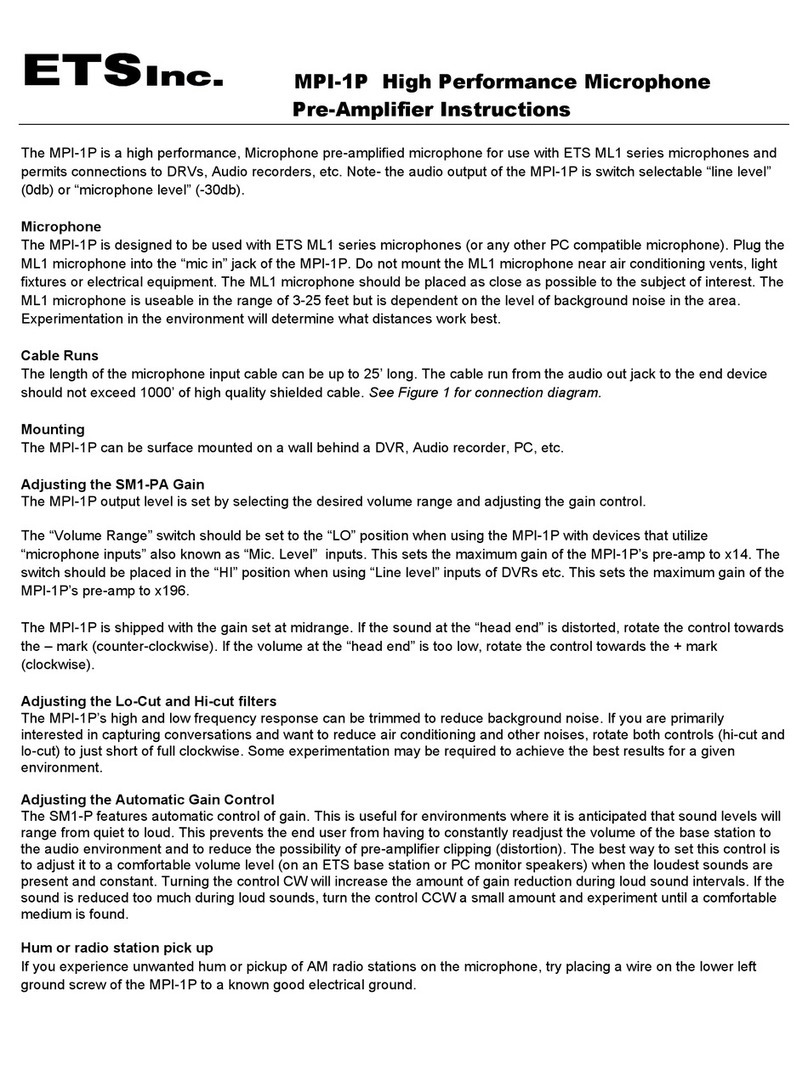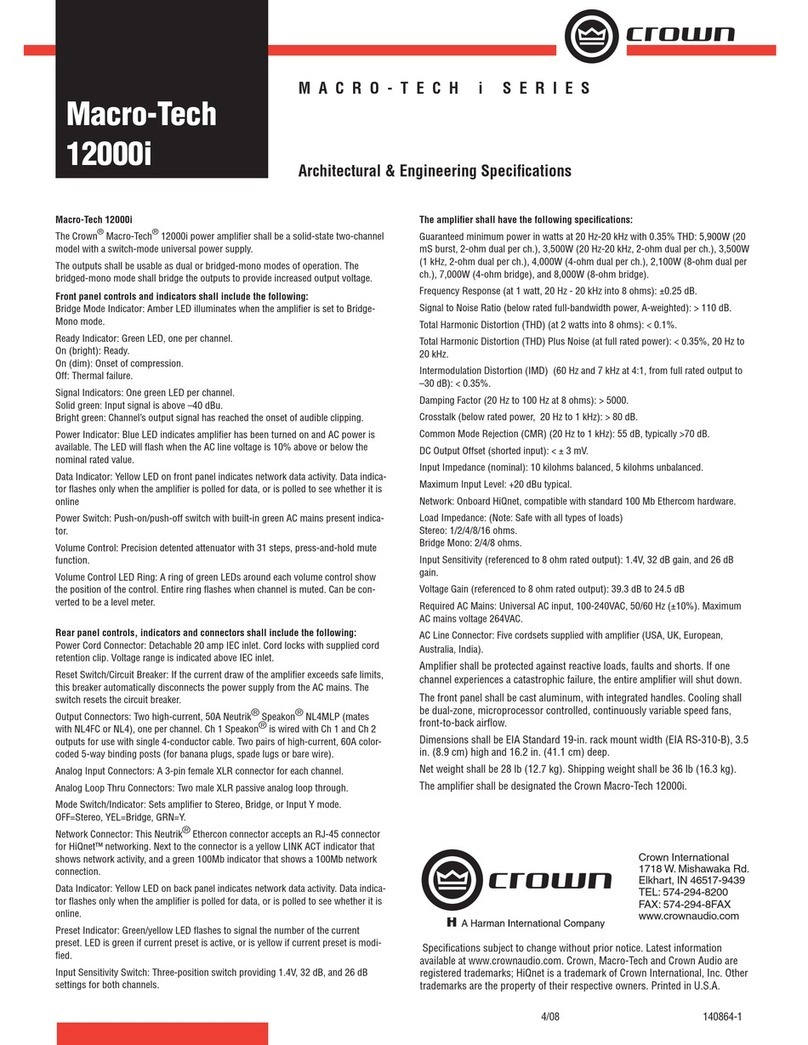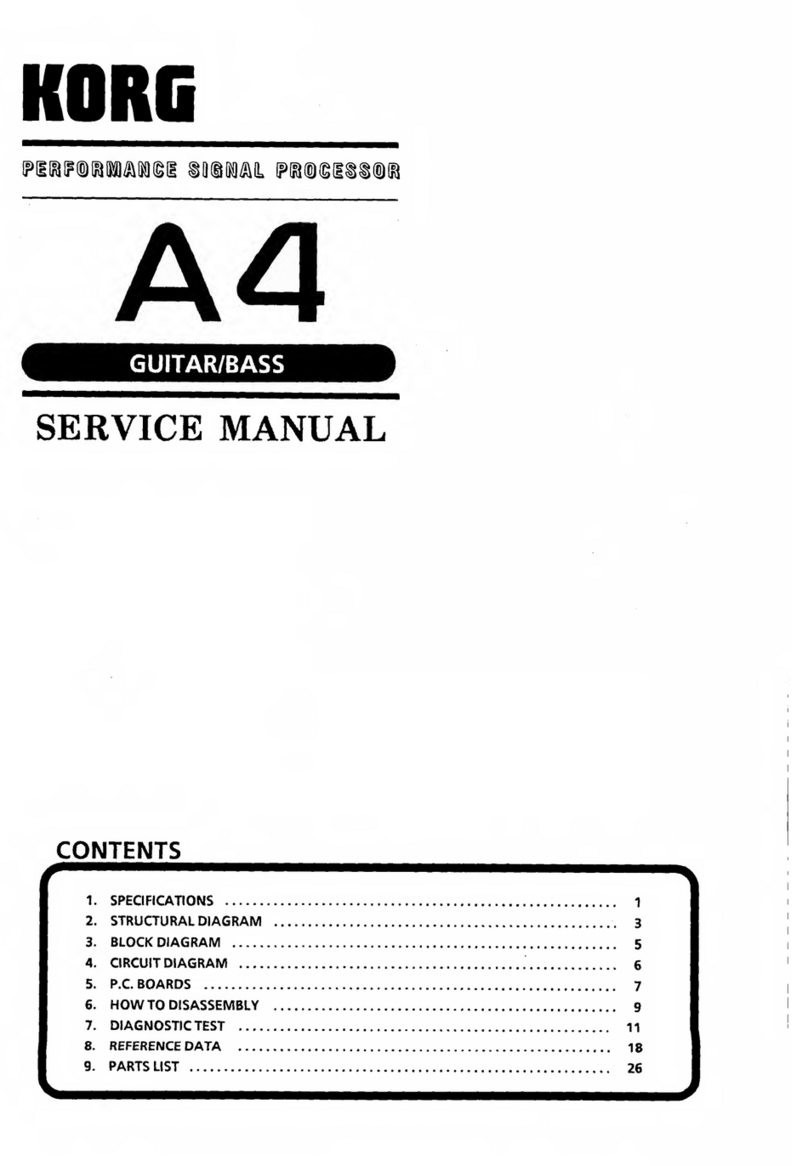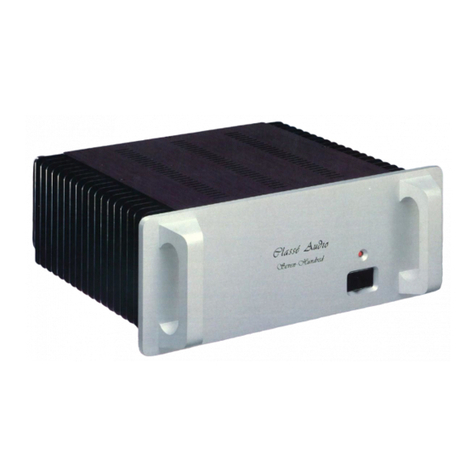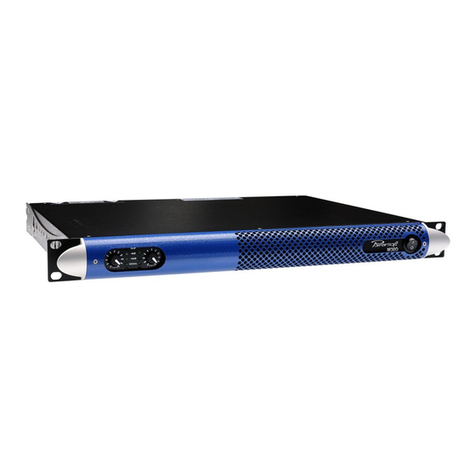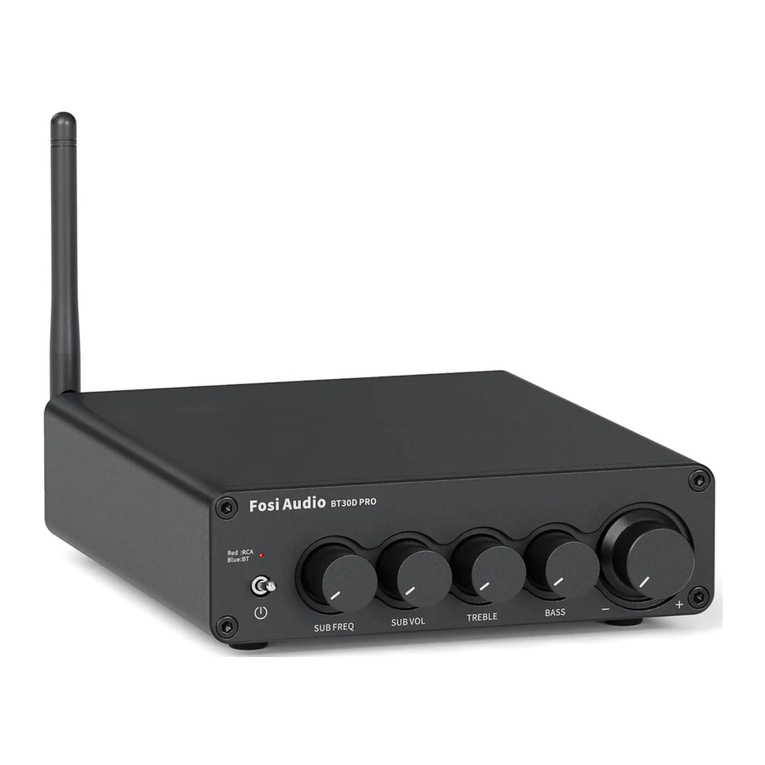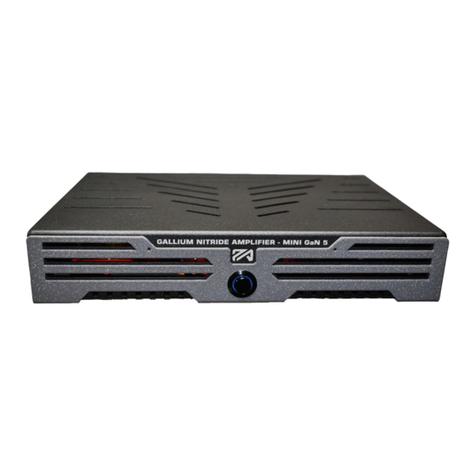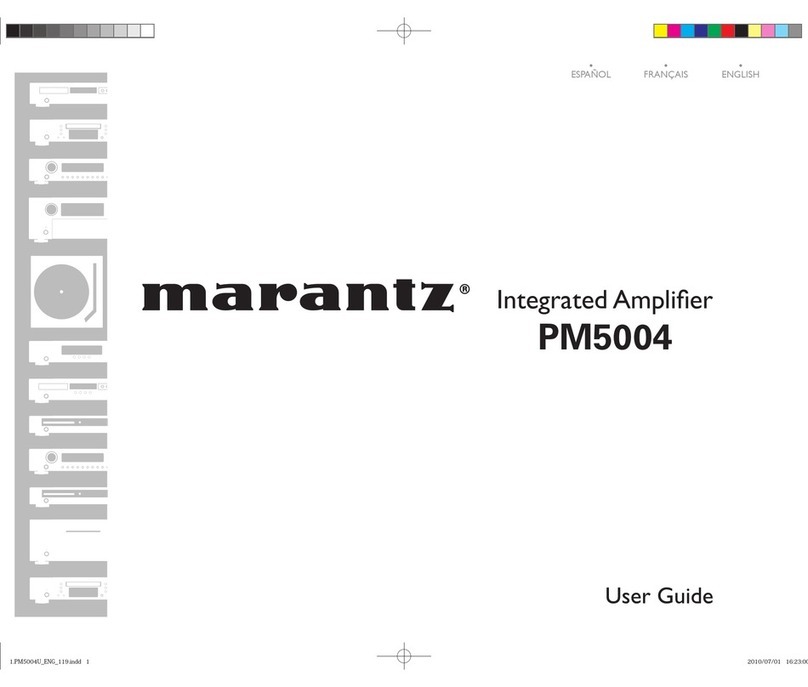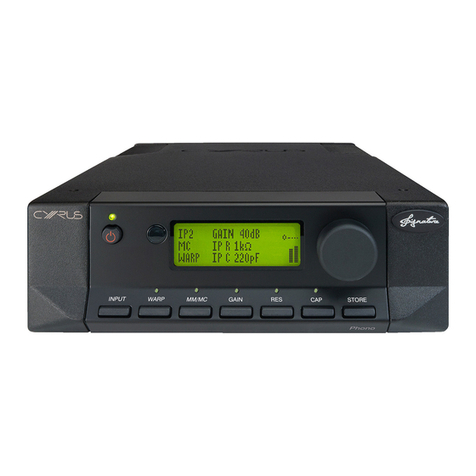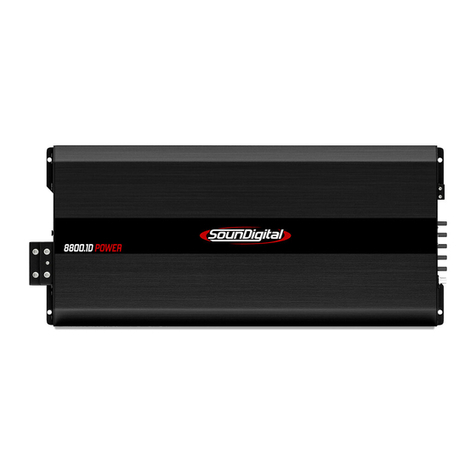SRK Electronics FMA501 User manual

(ACN 089 050 564 ABN 44 089 050 564)
8 Victoria Grove
Hawthorn East
VIC 3123
Australia

SRK Electronics FMA501 manual
2007 SRK Electronics Pty Ltd 1
FMA501 Manual
Safety notice
1 General description
2 Unpacking
3 Installation
4 Operation
4.1 Front panel
4.2 Rear panel
4.3 Switching on and off
4.4 Initial setup
4.5 Measuring other parameters
4.6 Setting power supply voltage
4.7 Setting the date and time
4.8 Protection
4.9 Remote operation
5 Maintenance
5.1 Recommended maintenance schedule
6 Circuit description
6.1 Equipment overview
6.2 Power supply
6.3 Control board
6.4 Amplifier palette
6.5 Output directional coupler
7 Trouble shooting
7.1 Diagnostics
7.2 Disassembly
Drawings

SRK Electronics FMA501 manual
2007 SRK Electronics Pty Ltd 2
Safety note
This equipment uses high voltages internally. Any servicing should be performed by
competent individuals.
Prolonged exposure to high level RF radiation has been shown to pose a health risk.
Whilst the equipment is intrinsically safe, its use in conjunction with an antenna
system may generate large RF fields. Appropriate precautions should be taken by
individuals that habitually work close to the transmitting antenna.
The RF power devices of this equipment employ Beryllium Oxide. This substance is
extremely toxic if pulverised. On no account should any RF power devices be
smashed. Please refer to attached Material Safety Data Sheet for further information.
WARNING
THIS EQUIPMENT IS SUPPLIED WITH A MAINS LEAD INCORPORATING
AN EARTH WIRE. IT IS IMPERATIVE THAT THIS EQUIPMENT IS
CONNECTED TO A MAINS OUTLET THAT HAS AN EARTH. IN
COUNTRIES WHERE EARTHED OUTLETS ARE NOT MANDATORY, IT IS
THE CUSTOMER’S RESPONSIBILITY TO ENSURE THAT THIS
EQUIPMENT IS APPROPRIATELY EARTHED.

SRK Electronics FMA501 manual
2007 SRK Electronics Pty Ltd 3
1 GENERAL DESCRIPTION
The FMA501 is a high quality 500W amplifier intended for audio broadcast service in the FM
band.
Its features include:
•Wideband
•Energy efficient and high power factor
•Extensive metering
•Rugged design.
•Conservatively rated.
•Comprehensive telemetry.
•Flexible configuration.
Applications include standalone medium power transmitters and multiple units for high power
FM transmitters.
The FMA501 is designed and built in Australia.

SRK Electronics FMA501 manual
2007 SRK Electronics Pty Ltd 4
2 UNPACKING
This section details the way in which the FMA501 should be unpacked upon receipt by the
customer.
Note that if the FMA501 is installed in an SRK Electronics transmitter then this section is not
applicable.
The FMA501 should be removed from its packing, and the packing stored and used should it
be necessary to return the FMA501 to the manufacturer.
Along with the amplifier, the following items should also be present:
•This manual
•Mains lead
The customer should ensure that all items are present and then store them in a safe place.

SRK Electronics FMA501 manual
2007 SRK Electronics Pty Ltd 5
3 INSTALLATION
3.1 General
This section describes the installation and infrastructure requirements for the FMA501.
Departure from the instructions contained herein may void any warranty provided by SRK.
The FMA501 has been designed to be mounted in a standard 19” rack frame, where it will
occupy 3 rack units. Due to the weight of this unit, rear supports are also recommended.
However, the amplifier may also be used in a free standing situation, so long as all other
requirements are met as below.
3.2 Environmental
The amplifier is intended for indoor use. The amplifier should be protected from rainfall and
direct sunlight, extremes of temperature and humidity and from conditions of high dust levels.
The amplifier shall not be operated at altitudes in excess of 3500m above sea level. The
amplifier must be installed on a flat, stable surface. The amplifier must be installed in the
upright position. The amplifier must be installed in a location free from vermin and the ingress
of other animals. The amplifier shall not be installed in locations prone to flooding. All
ventilation orifices must be clear to allow adequate air flow.
3.3 Electrical supply
The electrical supply to the amplifier must be of the voltage, form and frequency described in
the specifications. All electrical wiring must be carried out in accordance with local laws,
standards and regulations. If power supply voltages regularly fall outside specifications then
a voltage regulator must be installed between the supply inlet and the amplifier.
3.4 Earthing
Adequate earthing of the amplifier is vital to ensure long term reliability and user safety. The
electrical supply must be earthed, via the earthing pin of the IEC connector. In countries
where power outlet earthing is merely optional, an earthed outlet must be used. See safety
notice at the front of this manual. A separate, independent, earth is required for the
amplifier/antenna system and must be connected to the earthing point indicated on the rear of
the amplifier. The cable used to connect the earth should be as thick as possible, with 8 AWG
being the smallest size acceptable. Where possible, broad earthing band should be used.
In addition to the earth connection to the amplifier, the outer conductor of the coax feed to the
antenna should be connected to the earth, as indicated below.

SRK Electronics FMA501 manual
2007 SRK Electronics Pty Ltd 6
The earth itself must be of high quality buried copper, at least 1.5m deep and preferably in
ground that is habitually humid (eg, the base of a gutter down pipe).
3.5 Antenna
The antenna load connected to the amplifier must be tuned to minimise reflections. Whilst the
amplifier is designed to withstand high levels of reflection for short periods, continually high
levels of reflected power will degrade the long term reliability of the amplifier. Operating SWR
should be kept to below 1.9:1.

SRK Electronics FMA501 manual
2007 SRK Electronics Pty Ltd 7

SRK Electronics FMA501 manual
2007 SRK Electronics Pty Ltd 8

SRK Electronics FMA501 manual
2007 SRK Electronics Pty Ltd 9
4 OPERATION
4.1 Front Panel
Please refer to figure 4.1. The numbers of the following paragraphs refer to the controls
shown in figure 4.1.
1 Air inlets
Allows cooling air to enter the amplifier. Under no circumstances must these be blocked.
2 Control knob
Used to select which parameter is displayed on the LCD. Also used to modify some
parameters.
3 LCD
The current parameter is displayed on the LCD, as well as any alarm conditions.
4.2 Rear panel.
Please refer to figure 4.2. The numbers of the following paragraphs refer to the controls
shown in figure 4.2.
5 Air outlets
Allows hot air to exit the amplifier. Under no circumstances must these be blocked, and any
external objects must be at least 500mm from the rear surface of the amplifier.
6 Remote connector
Remote operation is performed by making connection to this DB9 socket. Please refer to
section 4.9 for details
7 Mains input.
This is the mains input, 240V AC unless specified by the customer. Mating connector is IEC
female. Any connection made to this socket must incorporate a safety earth.
8 Mains circuit breaker
Mains over current protection. Button pops out under overload condition. Press to reset. If
fault persists investigate possible power supply failure.
9 Earth stud.
This is an M6 stud for connecting an earth. This is recommended for superior lightning
protection.
10 RF out.
This is the RF output and is connected to either the antenna (for stand-alone applications), or
the RF combiner unit. Mating connector is N type male, 50Ω.
11 RF in
This is the RF input and is connected to the driving exciter. Mating connector is N type male,
50Ω.
4.3 Switching on and off
The FMA501 is switched on by applying mains power. The LCD will light and show “Fwd
Pwr”, meaning forward power, in watts. The FMA501 is now in operating mode. Assuming

SRK Electronics FMA501 manual
2007 SRK Electronics Pty Ltd 10
there are no alarms and the unit has not been put into standby mode previously, the fans
should start.
4.4 Initial setup
Assuming that the amplifier has been correctly installed, enough RF input power should be
applied to give the desired forward output power. Initially set the drive power to zero and
slowly increase until the forward power, as shown on the LCD, is at the required level. Note
that it is not advisable to generate powers in excess of 500W.
4.5 Measuring other parameters
Once the correct forward power has been established, the other amplifier parameters may be
checked. The available parameters are as follows and can be accessed in turn by rotating
the control knob clockwise to go down the list, or anticlockwise to go up the list:
“Fwd Pwr” Forward RF output power in watts
“Ref Pwr” Reflected RF output power in watts
“”I/P Pwr” Input RF power in watts
“A Temp” Amplifier A temperature in °C
“”Amp A I” Amplifier A DC current in amps
“B Temp” Amplifier B temperature in °C
“Amp B I” Amplifier B DC current in amps
“Amp Volt” Amplifier DC voltage in volts
“AC Volts” Input line voltage in volts
Data and time, British 24 hour format
“Elapsed” Total number of days running
Selecting any of these parameters has no effect on the operation of the amplifier
4.6 Setting power supply voltage.
When running at output powers of less than 300W, improved efficiency and lower device
dissipation can be achieved by reducing the amplifier DC supply voltage to lower than the
nominal 50V. This PSU cut function can be performed via the front panel by selecting the
“Amp Volt” parameter and then momentarily pressing the control knob inwards. It will be
noticed that the indicated voltage will drop to a nominal value of 35V. Pressing the button
again will return the voltage to 50V.
If desired, the PSU voltage in the cut state can be adjusted using VR16 on the control board.
For security, the ability to select/deselect this function using the front panel can be disabled
using the FD command via remote control.
4.7 Setting the date and time.
The current date and time can be set by selecting date and time using the control knob.
Pressing the knob momentarily will make the years value flash. Whilst it is flashing, rotate the
knob until the current year is displayed. Press the knob momentarily and the month will now
start flashing. Set as per years and continue through day, hours, minutes and finally seconds.
When done, press the knob again and the flashing will stop. The date and time have now
been set.
For security, the ability to select/deselect this function using the front panel can be disabled
using the FD command via remote control.

SRK Electronics FMA501 manual
2007 SRK Electronics Pty Ltd 11
4.8 Protection
The FMA501 incorporates a number of protective features that make it extremely rugged.
If the reflected power from the antenna exceeds 50W then the output RF power will be
automatically reduced to bring the reflected power back to 50W. Under this condition the
FMA501 will continue to function, albeit at a reduced output power, indefinitely until the
reflected power reduces. The LCD will show “SWR HIGH”.
The forward power is limited to 550W. “RF HIGH” will be shown on the LCD under this
condition. RF input power should be reduced.
If the RF input power exceeds 20W, the amplifier will totally shutdown until the input power is
reduced to less than 10W.
If the temperature of the RF amplifier becomes excessive, then the RF output power will be
reduced to zero until the amplifier temperature falls to an acceptable level. During this time
the LCD will show “TEMPERATURE HIGH”. The upper limit for heatsink temperature is
85°C.
If the AC line voltage drops below 200V then the amplifier will shut down until line volts
exceeds 210V. The LCD will show “UNDER AC VOLTS”.
If the AC line voltage exceeds 275V then the amplifier will shut down until the line volts falls
below 260V. The LCD will show “OVER LINE VOLTS”.
4.9 Remote operation.
The FMA501 may be monitored and controlled remotely via the “TELEMTRY” connector on
the rear of the unit. This is an RS232 standard connection with the following characteristics:
Baud rate: 9600
Data bits: 8
Parity: NONE
Stop bits: 1
Flow control: NONE
The pinout for the DB9 connector is as follows: pin 2, transmit data, pin 3, receive data, pin 5,
common (0V). All other pins are not connected.
The FMA501 responds to the following commands. <CR> indicates the ASCII character 0D
hex. All letters are upper case, spaces (20 hex) are indicated by “_”. All commands must be
terminated by <CR>. Note that a line feed (0A hex) must not be sent before or after <CR>.
After a response is sent, a carriage return, line feed and “>” are sent.
FP?<CR>
Returns forward power in the form XXXW<LF><CR>>. For example:
FP?<CR> (command)
500W<LF><CR> (response from amplifier)
>
Note that for forward powers of 99W and below, the leading zero is replaced with a space
RP?<CR>

SRK Electronics FMA501 manual
2007 SRK Electronics Pty Ltd 12
Returns reflected power in the form XXXW<LF><CR>>. For example:
RP?<CR> (command)
_00W<LF><CR> (response from amplifier)
>
Note that for reflected powers of 99W and below, the leading zero is replaced with a space.
IP?<CR>
Returns the input power in the form XX.XW<LF><CR>>. For example:
IP?<CR> (command)
_7.5W<LF><CR> (response from amplifier)
>
Note that for input powers of 9.9W and below, the leading zero is replaced with a space.
AAT?<CR>
Returns the amplifier A temperature in the form XXXC<LF><CR>>. For example:
AAT?<CR> (command)
_32C<LF><CR> (response from amplifier)
>
Note that for temperatures of 99C and below, the leading zero is replaced with a space.
AAI?<CR>
Returns amplifier A DC current in the form XX.XA<LF><CR>>. For example:
AAI?<CR> (command)
_7.5A<LF><CR> (response from amplifier)
>
Note that for currents of 9.9A and below, the leading zero is replaced with a space.
ABT?<CR>
Returns the amplifier B temperature in the form XXXC<LF><CR>>. For example:
ABT?<CR> (command)
_32C<LF><CR> (response from amplifier)
>
Note that for temperatures of 99C and below, the leading zero is replaced with a space.
ABI?<CR>
Returns amplifier B DC current in the form XX.XA<LF><CR>>. For example:
ABI?<CR> (command)
_7.5A<LF><CR> (response from amplifier)
>

SRK Electronics FMA501 manual
2007 SRK Electronics Pty Ltd 13
Note that for currents of 9.9A and below, the leading zero is replaced with a space.
AV?<CR>
Returns the amplifier DC supply voltage in the form XX.XV<LF><CR>>. For example:
AV?<CR> (command)
50.1V<LF><CR> (response from amplifier)
>
Note that for voltages of 9.9V and below, the leading zero is replaced with a space.
LV?<CR>
Returns the line voltage in the form XXXV<LF><CR>>. For example:
LV?<CR> (command)
240V<LF><CR> (response from amplifier)
>
Note that for voltages of 99V and below, the leading zero is replaced with a space.
TD?<CR>
Returns the current time and date in the form XX:XX:XX_XX/XX/XX<LF><CR>>. For
example:
TD?<CR> (command)
14:27:07_02/05/06<LF><CR> (response from amplifier)
>
ET?<CR>
Returns the number of elapsed days the unit has been running in the form
XXXXX_DAYS<LF><CR>>. For example:
ET?<CR> (command)
__576_DAYS<LF><CR> (response from amplifier)
>
Note that the three leading zeros are blanked with spaces.
PS?<CR>
Returns the current front panel status. For example:
PS?<CR> (command)
Locked<LF><CR> (response from amplifier indicating that the front panel is locked)
>
or
Unlocked<LF><CR> (response from amplifier indicating that the front panel is unlocked)
>
ST?<CR>
Returns the current standby/running status. For example:
ST?<CR> (command)
Standby<LF><CR> (response from amplifier indicating that it is in standby)
>
or

SRK Electronics FMA501 manual
2007 SRK Electronics Pty Ltd 14
Running<LF><CR> (response from amplifier indicating that it is running)
>
PC?<CR>
Returns the current PSU cut status. For example:
PC?<CR> (command)
Off<LF><CR> (response from amplifier indicating that PSU cut is off)
>
or
On<LF><CR> (response from amplifier indicating that PSU cut is on)
>
BS?<CR>
Returns the current self test status in the form XXXXX<LF><CR>>, where X can be either 0
or 1. A 1 indicates a failure, a 0 indicates a pass. The first byte indicates line volts high, the
second indicates line volts low, the third indicates high temperature, the fourth indicates a
high input RF condition, the fifth indicates a high SWR condition and the sixth indicates a high
RF output power condition. For further information consult the section on protection. For
example:
BS?<CR>(command)
000010<LF><CR> (response from amplifier indicating a high SWR condition)
>
or
000000<LF><CR> (response from amplifier indicating no failures)
>
FE<CR>
Unlocks the front panel to allow parameters to be altered locally. For example:
FE<CR> (command to enable the front panel)
Ok<LF><CR> (response from amplifier indicating that command has been
> executed)
FD<CR>
Locks front panel. Parameters can be measured but not changed locally. For example:
FD<CR> (command to disable front panel)
Ok<LF><CR> (response from amplifier indicating that command has been
> executed)
SD=XX/XX/XX<CR>
Sets the date according to XX/XX/XX. For example:
SD=23/07/06<CR> (command)
Ok<LF><CR> (response from amplifier indicating that command has been
>executed)
ST=XX:XX:XX<CR>
Sets the time according to XX:XX:XX. For example:

SRK Electronics FMA501 manual
2007 SRK Electronics Pty Ltd 15
ST=11:45:32<CR> (command)
Ok<LF><CR> (response from amplifier indicating that command has been
>executed)
ON<CR>
Turns the amplifier on from a standby condition. The fans and the main PSU will start upon
receipt of this command. For example:
ON<CR> (command)
Ok<LF><CR> (response from amplifier indicating that command has been
>executed)
OFF<CR>
Turns the amplifier off into a standby condition. The fans and the main PSU will shutdown
upon receipt of this command. For example:
OFF<CR> (command)
Ok<LF><CR> (response from amplifier indicating that command has been
>executed)
PE<CR>
Enables PSU cut. The power supply voltage will drop to a nominal value of 35V upon receipt
of this command. For example:
PE<CR> (command)
Ok<LF><CR> (response from amplifier indicating that command has been
>executed)
PD<CR>
Disables PSU cut. The power supply voltage will rise to a nominal value of 50V upon receipt
of this command. For example:
PD<CR> (command)
Ok<LF><CR> (response from amplifier indicating that command has been
>executed)
HP?<CR>
Returns a summery of the above commands.
Any data received by the amplifier, other than the commands listed above will generate the
following error string:
Invalid_command.__Send_HP?(CR)_for_command_syntax.<LF><CR>
>
Any data outside the valid range for the parameter concerned will generate the following error
string:
Incorrect_value_or_syntax.__Send HP?(CR)_for_help.<LF><CR>
>

SRK Electronics FMA501 manual
2007 SRK Electronics Pty Ltd 16
Should it be necessary to make connection to the remote port using cables running external
to the building housing the FMA501, it is recommended that external filtering and transient
protection be installed on these lines.

SRK Electronics FMA501 manual
2007 SRK Electronics Pty Ltd 17
5 MAINTENANCE
5.1 Recommended maintenance schedule
The FMX501 will give many years of trouble free service with little or no attention
The air filter on the front panel should be regularly inspected and cleaned gently with warm
water if necessary.
If the operation of the date and time becomes erratic then replace the button cell on the
control board.

SRK Electronics FMA501 manual
2007 SRK Electronics Pty Ltd 18

SRK Electronics FMA501 manual
2007 SRK Electronics Pty Ltd 19
6 CIRCUIT DESCRIPTION
6.1 Equipment Overview
The FMA501 consists of the following sub-assemblies:
•Power Supply
•Control board
•Amplifier palette
•Output directional coupler
These assemblies are interconnected as per “FMA501 wiring diagram”.
Please refer to fig 6.1 for the physical location of each sub-assembly.
The power supply provides a nominal 50V DC for the RF transistors.
The control board contains all metering and protection functions.
The amplifier palette contains most RF functions.
The output directional coupler allows accurate metering of forward and reflected power.
6.2 Power Supply and Metering board
The power supply is an OEM unit, manufactured by Meanwell, p/n RFP-1500-48. Full
specifications can be found at www.meanwell.com.
Apart from the mains input and DC output, the control connector is used to switch the unit off
and on and to reduce the output voltage whilst PSU cut is enabled.
Energising the diode between pins 1 and 2 of CN2 switches the PSU off. A variable
resistance between pins 3 and 4 allows the output voltage to be reduced.
6.3 Control Board
The control board is responsible for all measurement and protection functions. Refer to the
appropriate schematic.
The heart of the controller board is U1, a micro-controller unit. This performs the following
functions:
The analogue voltages representing the forward and reverse powers are digitised on pins 40
and 39. These values are then squared internally to allow the forward and reflected power to
be read on the front panel and via telemetry.
Due to the limited number of pins, all other analogue voltages to be read (input power,
amplifier currents, amplifier temperatures and DC supply voltage) are routed through an
external MUX (U6) into pin 38. Thus allowing these parameters to be measured.
Pin 36 provides a digital signal that is used to assert the PSU cut function. This is done by
energising RL1, via Q1. VR16 sets the actual voltage in the PSU cut state.
Table of contents
Popular Amplifier manuals by other brands

Federal Signal Corporation
Federal Signal Corporation PA300-100 Installation and maintenance instructions

Aiwa
Aiwa ST-R22H Service manual
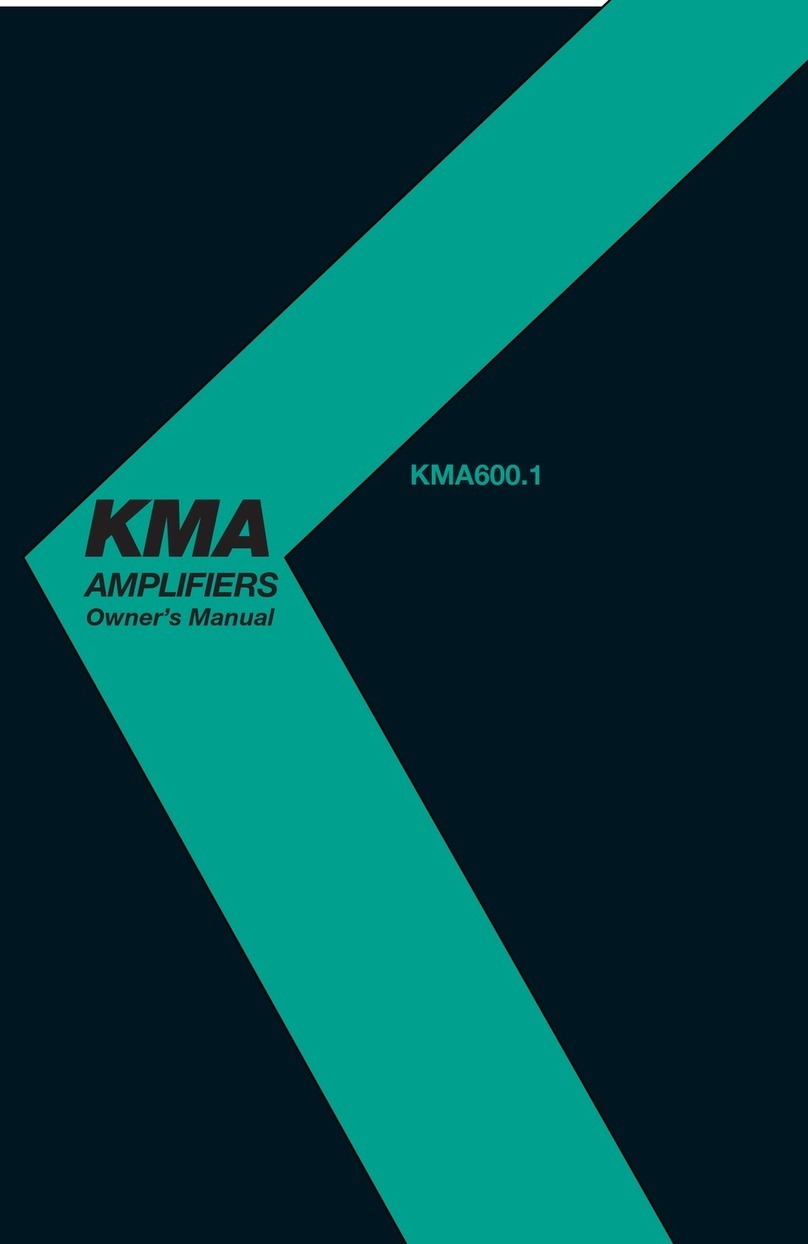
KMA
KMA KMA600.1 owner's manual
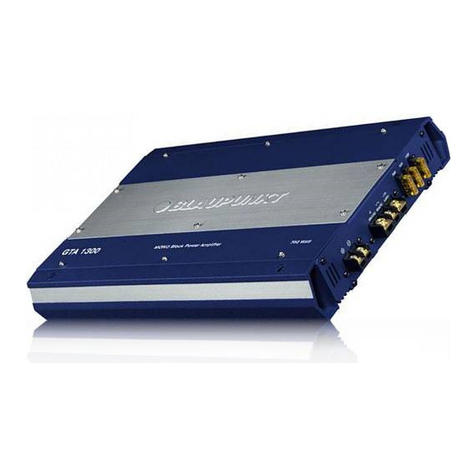
Blaupunkt
Blaupunkt GTA 1300 Operating and installation instructions
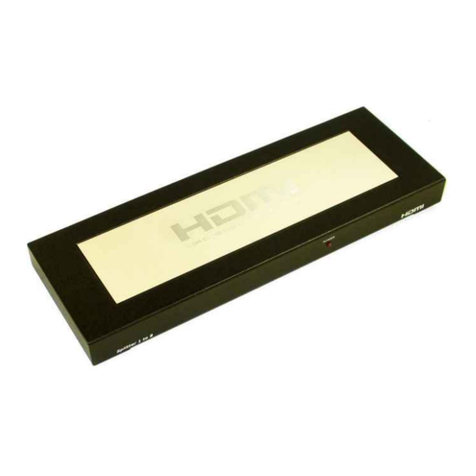
Converters.TV
Converters.TV 504 Operation manual
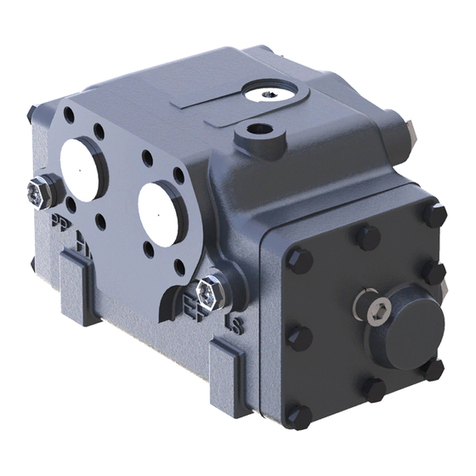
Danfoss
Danfoss OSQA Service manual
